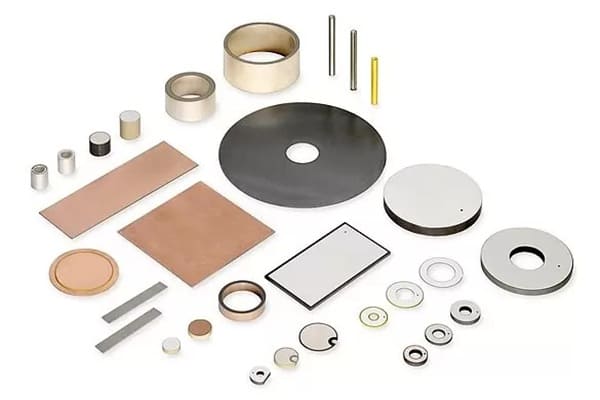Why Are Lead-free Piezoelectric Ceramics Preferred in Modern Electronics?
Piezoelectric ceramics are materials that generate an electric charge in response to mechanical stress or, conversely, deform when subjected to an electric field. This unique property makes them indispensable in modern electronics, powering devices like sensors, actuators, and transducers. Traditionally, lead-based piezoelectric ceramics, such as lead zirconate titanate (PZT), have dominated the industry due to their exceptional piezoelectric performance. However, concerns over environmental sustainability and human health have driven a shift toward lead-free alternatives. The transition to lead-free piezoelectric ceramics reflects a broader movement in electronics manufacturing to prioritize eco-friendly materials without compromising functionality.
At Advanced Ceramics Hub, we specialize in high-quality ceramic products with a variety of forms and specifications, ensuring optimal performance for industrial and scientific applications.

What Is Piezoelectric Ceramic?
Piezoelectric ceramic is a type of smart material that converts mechanical energy (such as pressure or vibration) into electrical energy (piezoelectric effect) and vice versa (inverse piezoelectric effect). These ceramics are widely used in sensors, actuators, transducers, and other electronic devices due to their ability to generate electricity when deformed or change shape when an electric field is applied.
Key Properties of Piezoelectric Ceramics:
- Piezoelectric Effect – Generates an electric charge in response to mechanical stress.
- Inverse Piezoelectric Effect – Expands or contracts when an electric field is applied.
- High Sensitivity – Responds to small mechanical changes with measurable electrical signals.
- Durability – Resistant to wear and corrosion, making them suitable for harsh environments.
- Wide Frequency Range – Effective for both low and high-frequency applications.
Common Piezoelectric Ceramic Materials:
- Lead Zirconate Titanate (PZT) – The most widely used due to its strong piezoelectric properties.
- Barium Titanate (BaTiO₃) – One of the first discovered piezoelectric ceramics.
- Potassium Sodium Niobate (KNN) – A lead-free alternative for eco-friendly applications.
- Zinc Oxide (ZnO) – Used in thin-film piezoelectric applications.
Applications of Piezoelectric Ceramics:
- Sensors & Transducers (e.g., accelerometers, pressure sensors, ultrasonic imaging)
- Actuators (e.g., precision positioning in microscopes and robotics)
- Energy Harvesting (e.g., converting vibrations into electricity)
- Ultrasonic Devices (e.g., medical ultrasound, cleaning devices)
- Ignition Systems (e.g., gas lighters, spark generators)
- Acoustic Devices (e.g., speakers, microphones)
Advantages Over Other Piezoelectric Materials:
- Higher piezoelectric coefficients than natural crystals (like quartz).
- Can be engineered for specific applications by adjusting composition.
- Cost-effective and easy to manufacture in various shapes.
Looking for top-quality ceramic products? Explore Advanced Ceramics Hub’s selection.
Environmental and Health Concerns of Lead-Based Piezoelectric Ceramics
Lead-based piezoelectric ceramics, particularly PZT, have been widely used due to their high piezoelectric coefficients and stability. However, lead is a toxic heavy metal that poses severe risks to both human health and the environment. Exposure to lead can cause neurological damage, developmental issues in children, and other health problems. In manufacturing, lead can contaminate water sources and soil, leading to long-term ecological damage. The disposal of lead-containing electronics further exacerbates these issues, as improper handling can release lead into landfills.
Global regulations have tightened restrictions on lead use in electronics to mitigate these risks. Key regulations include:
- RoHS (Restriction of Hazardous Substances): Enacted by the European Union, RoHS limits the use of hazardous materials, including lead, in electronic and electrical equipment.
- REACH (Registration, Evaluation, Authorisation, and Restriction of Chemicals): This EU regulation restricts the use of harmful substances in manufacturing and encourages safer alternatives.
- Other Regional Laws: Countries like China, Japan, and the United States have implemented similar restrictions, pushing manufacturers toward compliance.
The push for sustainable alternatives has made lead-free piezoelectric ceramics a priority. By eliminating lead, manufacturers can reduce environmental pollution and health risks, aligning with global sustainability goals. This shift is not only a response to regulatory pressure but also a reflection of consumer demand for greener products.
Explore our optimized ceramic products.
Advantages of Lead-Free Piezoelectric Ceramics
Lead-free piezoelectric ceramics offer several compelling advantages, making them a preferred choice in modern electronics. These advantages include environmental safety, comparable performance to lead-based materials, and versatility in applications. Below is a detailed breakdown:
1. Environmental & Health Benefits
✅ Non-Toxic – Free from lead (Pb), eliminating risks of lead poisoning and contamination.
✅ RoHS & REACH Compliance – Meet strict regulations (e.g., EU RoHS, China RoHS) for hazardous substance restrictions.
✅ Easier Disposal & Recycling – No special handling required for electronic waste, reducing environmental impact.
2. Growing Performance Improvements
✅ Good Piezoelectric Properties – Some lead-free materials (e.g., KNN, BNT-BT, BFO) now achieve moderate d₃₃ (charge coefficient) and kₚ (coupling factor) values.
✅ High Thermal Stability – Certain compositions (e.g., BNT-based ceramics) maintain performance at elevated temperatures.
✅ Energy Efficiency – Improved energy harvesting capabilities for sustainable power generation.
| Material Type | Piezoelectric Coefficient (pC/N) | Toxicity | Regulatory Compliance |
| PZT (Lead-Based) | 200–600 | High | Non-compliant |
| KNN (Lead-Free) | 100–400 | None | Compliant |
| BaTiO₃ (Lead-Free) | 100–200 | None | Compliant |
3. Versatility in Applications
Lead-free ceramics are used in a wide range of devices, including sensors for detecting vibrations, actuators for precise motion control, and transducers for converting energy. Their adaptability makes them ideal for industries ranging from consumer electronics to aerospace.
By offering a balance of performance and sustainability, lead-free piezoelectric ceramics are becoming the material of choice for forward-thinking manufacturers.
Discover our high-quality ceramic products.
Technological Advancements in Lead-Free Piezoelectric Ceramics
The development of lead-free piezoelectric ceramics has been driven by significant technological advancements. Researchers have focused on creating materials that rival the performance of PZT while maintaining environmental safety. Key innovations include:
- Material Innovations: New lead-free materials, such as potassium-sodium niobate (KNN), bismuth sodium titanate (BNT), and barium titanate-based ceramics, have emerged as viable alternatives. These materials are engineered to achieve high piezoelectric coefficients and thermal stability. For instance, KNN ceramics have been optimized through doping with elements like lithium or tantalum to enhance their electromechanical properties.
- Improved Manufacturing Processes: Advances in synthesis techniques, such as sol-gel methods and spark plasma sintering, have improved the density and uniformity of lead-free ceramics. These processes enhance the materials’ mechanical and electrical properties, making them more reliable for industrial applications.
- Research and Development: Ongoing R&D efforts are focused on improving the scalability and cost-effectiveness of lead-free ceramics. Collaborative projects between universities, research institutes, and industry players are accelerating the development of next-generation materials.
These advancements have made lead-free ceramics more competitive, enabling their integration into high-performance electronic systems. Continued innovation is expected to further close the performance gap with lead-based materials.
Request a custom quote for high-quality ceramic products.
Applications of Lead-free Piezoelectric Ceramic in Modern Electronics
Lead-free piezoelectric ceramics (e.g., KNN, BNT, BaTiO₃) are increasingly used in consumer electronics, medical devices, and industrial systems due to their eco-friendliness and improved performance. Below are key applications across industries:
1. Consumer Electronics
(a) Haptic Feedback in Smartphones & Wearables
- KNN-based actuators provide vibrations in touchscreens, gaming controllers, and smartwatches.
- Advantage: Lead-free materials are safer for skin contact.
(b) Ultrasonic Fingerprint Sensors
- BNT thin films enable under-display ultrasonic sensors (e.g., Qualcomm 3D Sonic).
- Advantage: Higher resolution than optical sensors.
(c) Speakers & Microphones
- BaTiO₃ composites in miniature speakers (e.g., true wireless earbuds).
- Advantage: Better sound clarity with low harmonic distortion.
2. Medical Devices
(a) Ultrasound Imaging
- KNN-based transducers replace PZT in portable ultrasound machines.
- Advantage: No lead leaching risk for patient safety.
(b) Implantable Sensors
- BNT-PVDF flexible films monitor blood pressure, muscle activity.
- Advantage: Biocompatible and MRI-safe.
(c) Drug Delivery Systems
- Piezoelectric micropumps (using BaTiO₃) enable precise drug dosing.
3. Automotive & Industrial Systems
(a) Knock Sensors in Engines
- KNN sensors detect engine knocking for fuel efficiency.
- Advantage: Withstands high temperatures (~200°C).
(b) Structural Health Monitoring
- Embedded BNT sensors detect cracks in bridges, aircraft.
- Advantage: Long-term durability in harsh environments.
(c) Energy Harvesting
- KNN patches convert tire vibrations into electricity for TPMS (Tire Pressure Monitoring Systems).
FAQ
| Question | Answer |
| 1. What are lead-free piezoelectric ceramics? | Lead-free piezoelectric ceramics are materials that generate electrical charge when mechanically stressed, made without using lead, often used as alternatives to lead-based ceramics like PZT. |
| 2. Why are lead-free piezoelectric ceramics preferred? | They are preferred because they are environmentally safer, comply with regulations like RoHS, and reduce the health risks associated with lead exposure. |
| 3. What are the environmental benefits of lead-free ceramics? | Lead-free ceramics reduce the risk of lead contamination in soil and water, are more recyclable, and contribute to more sustainable electronic manufacturing. |
| 4. How do lead-free piezoelectric ceramics compare to lead-based materials? | Lead-free ceramics can offer comparable or even superior performance in specific applications, but they may not match the high efficiency of lead-based materials in all cases. |
| 5. What are some examples of lead-free piezoelectric ceramics? | Common lead-free alternatives include sodium bismuth titanate (Na0.5Bi0.5TiO3), potassium sodium niobate (KNN), and barium titanate (BaTiO3). |
| 6. Are there challenges in using lead-free piezoelectric ceramics? | Yes, challenges include achieving the same level of performance as lead-based ceramics, and difficulties in material synthesis and processing for optimal properties. |
At Advanced Ceramics Hub, we supply optimized-grade ceramic products that comply with ASTM and ISO standards, ensuring outstanding quality and reliability.
Lead-free piezoelectric ceramics represent a significant step forward in the quest for sustainable electronics. Their environmental safety, compliance with global regulations, and improving performance make them a preferred choice over traditional lead-based materials like PZT. While challenges remain, technological advancements are rapidly closing the gap, enabling lead-free ceramics to power a wide range of applications, from consumer devices to medical and industrial systems. As the electronics industry continues to prioritize sustainability, the adoption of lead-free piezoelectric ceramics will play a crucial role in shaping a greener, healthier future.
For top-quality ceramic products, Advanced Ceramics Hub provides tailored solutions and precision machining techniques for various applications.
Looking for premium ceramic products? Contact us today!
